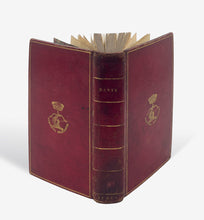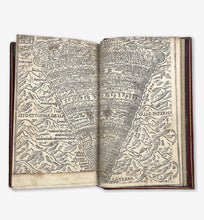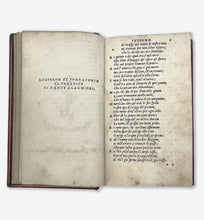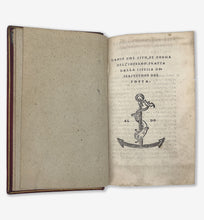
Lord Aberdeen's copy
DANTE Alighieri. Dante col sito, et forma dell’Inferno tratta dalla istessa descrittione del poeta. [(Colophon:) Venice, in the house of Aldo Manuzio and Andrea Torresano. August 1515.]
8vo. Early nineteenth-century red straight-grain morocco, gilt supralibros of George Hamilton-Gordon, 4th Earl of Aberdeen to boards (see below), borders filleted in gilt, flat spine filleted in gilt and lettered directly in gilt, gilt edges, marbled endpapers, green silk place marker; ff. [2], 244, [2] (diagrams), [1], italic type, woodcut Aldine devices to title-page, a1r, and final verso (supplied from another copy), three-line initial spaces with guide letters at the beginning of each cantica, three woodcut plates by Trifone Gabriele at end (two double-pages), one depicting the layout of Hell (ff. H4v-H5r), and other two with schematic diagrams of the sins in Hell (ff. H5v-H6r) and Purgatory (f. H6v); extremities and spine slightly rubbed; internally very good, lacking blank H7, upper margin of plates trimmed with loss of upper border, no to image but touching a few letters of Purgatory diagram; early ownership inscription “Di Thomaso C…” to f. a1r (washed); 19th-century library label with shelfmark to front pastedown.
The first illustrated Aldine edition of Dante’s Commedia, and the second overall, from the library of George Hamilton-Gordon (1784-1860), 4th Earl of Aberdeen and the last British Prime Minister to have undertaken the Grand Tour.
Prompted by the Bembo family, Aldo Manuzio drew upon manuscripts from the collection of Bernardo Bembo (1433-1519) to produce his authoritative edition of Dante. Bernardo’s son, scholar and future cardinal Pietro Bembo (1470-1547) collaborated with Aldo to refine the texts of the Commedia, which he published in 1502 as Le terze rime. This 1515 second edition, featuring Bembo’s diagrams of sins, was the first illustrated Aldine Commedia. It was published six months after Aldo Manuzio’s death on 6 February 1515 and dedicated by Andrea Torresano, Aldo’s father-in-law, to the poet Vittoria Colonna (1492-1547).
Provenance: From the library of George Hamilton-Gordon, 4th Earl of Aberdeen, sometime Foreign Secretary and Prime Minister from 1852 until 1855. Educated at Harrow and St John’s College, Cambridge, Aberdeen embarked on the Grand Tour in 1802 during the peace of Amiens. His travels took him from Paris – where his connection to William Pitt the Younger secured a meeting with Napoleon Bonaparte – to Rome, Naples, Sicily, Malta, Constantinople, and Athens. In Athens, he sought to purchase friezes from the Parthenon but found Lord Elgin had preceded him. He returned to England via Venice, Vienna, and Berlin in 1804.
Reputedly fluent in six languages, including Italian, Aberdeen was seemingly well-versed in Dante. In an 1851 letter addressing the Italian revolutions of 1848, Scottish writer Charles Macfarlane (1799-1858) invoked Purgatorio to describe the turbulence, writing, “Yet, even in the combustion of 1848, the passing from Turkey to Naples was like going from hell to purgatory. You read Dante, my Lord – Per correr miglior acqua, Alza la vela [sic] …” (Macfarlane, p. 40). This Aldine edition, elegantly bound with Aberdeen’s crest and motto to the boards, is most likely the copy he studied.
EDIT 16 CNCE 1150; Adams D-88; Renouard Alde 73, 8. See Macfarlane, A Letter to the Earl of Aberdeen (London: Routledge, 1851).
#2120511











